Analyzing the World Values Survey
In order to better understand the factors influencing public views of science, technology, and society across countries, we analyzed the sixth wave of the World Values Survey (WVS), conducted in sixty countries between 2010 and 2014. Every decade since the 1970s, the WVS project has conducted nationally representative surveys using a common questionnaire assessing global differences in behaviors, values, motivations, and social, political, and cultural beliefs. The 2010–2014 iteration of the WVS included items that tapped respondents’ beliefs about science, technology, and society.
The sixth wave of the WVS provides the most recent available data specific to how people across the globe perceive the societal promise of science and technology and the reservations that they might hold. In our analysis, after accounting for missing individual-level survey data and available country-level data, we eliminated six countries from our analysis: Haiti, Hong Kong, Iraq, Libya, Palestine, and Taiwan. Our final analysis therefore includes an assessment of public attitudes across fifty-four countries and eighty-one thousand survey respondents.
Measuring Science, Technology, and Society Beliefs
To evaluate beliefs about science, technology, and society, we analyzed three questions from the WVS that measured scientific optimism and three questions that measured scientific reservations. These questions are similar to those used by other researchers in previous studies separate from those carried out by the WVS team.23 Using a ten-point scale, with 10 representing the strongest agreement and 1 representing the least agreement, respondents were asked to agree or disagree with the following statements:
Scientific Optimism (Cronsbach alpha α = 0.74)
- Science and technology are making our lives healthier, easier, and more comfortable.
- Because of science and technology, there will be more opportunities for the next generation.
- All things considered, would you say that the world is better off, or worse off, because of science and technology? Please tell me which comes closest to your view on this scale: 1 means that “the world is a lot worse off,” and 10 means that “the world is a lot better off.”
Scientific Reservations (Cronsbach alpha α = 0.55)24
- One of the bad effects of science is that it breaks down people’s ideas of right and wrong.
- We depend too much on science and not enough on faith.
- It is not important for me to know about science in my daily life.
To limit missing responses to these questions, the “no answer” and “don’t know” responses from all six survey questions were recoded to the middle point (5.5) of the ten-point scale for each item. The two dependent measures, which are weakly correlated, were constructed by combining the average of the respective three survey items into a single index with final scores ranging from 1 to 10.
In Table 4, we detail how the populations of the fifty-four countries compare relative to sample mean scores on scientific optimism and scientific reservations. Each nation rates relatively high on scientific optimism, with the combined mean score at least 6 or higher on the ten-point scale. Most of the top-ranking countries are developing economies, with their populations likely viewing scientific achievement as vital to economic growth and improving living standards. Interestingly, seventeen of the nineteen countries that scored highest in terms of scientific optimism are post-Soviet or Muslim-majority countries. The exceptions are Rwanda and China, the latter sharing a history of communist ideological influence with post-Soviet/Eastern Bloc countries.
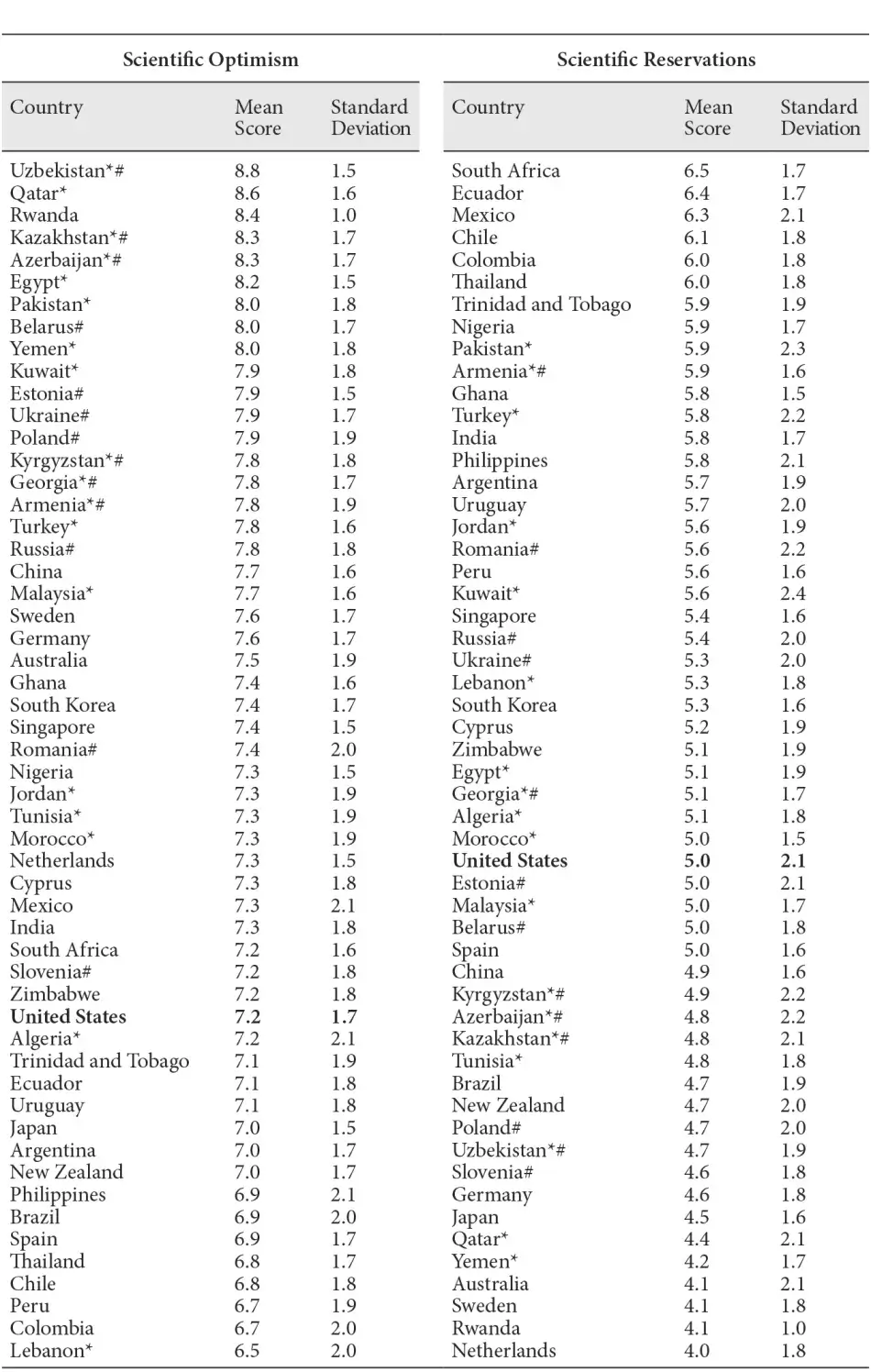
Scientific and technological progress was an integral part of Soviet ideology and identity; thus, we would expect the populations of countries with Soviet or Eastern Bloc heritage to stand out in their beliefs about science, technology, and society.25 The relationship between science and Islamic faith is more complex and has been the topic of considerable discussion in recent years. Although the gap in scientific advancement between Muslim countries and the rest of the world has widened, surveys also suggest that their citizens may hold a strong sense of optimism about science and technology.26 Analyzing cross-national surveys, the Pew Forum on Religion and Public Life, for example, has found that most people living in Muslim-majority countries do not see any conflict between science and their religion.27 In contrast to their negative feelings about U.S. foreign policy, people living in several Muslim-majority countries, including Malaysia, Indonesia, Jordan, Tunisia, Kuwait, and Lebanon, also express strong levels of admiration for U.S. science and technology, indicating a sense of hopeful aspiration about what science and technology can contribute to their own society.28
Specific to mean scores on scientific reservations, the fifty-four countries score relatively low in comparison with scores on scientific optimism. Per country, sample means range from 4 to 6.5 on a ten-point scale. Four of the top five countries relative to reservations are strong majority–Roman Catholic countries. Of the fifty-four countries surveyed, most of the post-Soviet/Eastern Bloc and Muslim-majority countries rank toward the bottom third in terms of reservations. Scoring at the bottom of the range are several of the most economically advanced countries, including Japan, Germany, Australia, and the Netherlands. The United States in comparison ranks about mid-tier among the fifty-four countries. Importantly, however, the U.S. mean score of 5.0 on reservations is considerably lower than its national mean score of 7.2 on scientific optimism.
Evaluating Country-Level and Individual-Level Factors
To be more confident about the country-level factors associated with beliefs about science, technology, and society, we ran a series of multilevel model (MLM) regressions predicting individual scores on scientific optimism and scientific reservations. These statistical models allow us to control for country-level factors such as the degree of human development, democratic development, scientific development, and the cultural history of a country, while also examining individual-level factors such as those related to socioeconomic status, personal beliefs and values, religiosity, and forms of institutional trust.
We examined in our statistical analysis the relationship between beliefs about science, technology, and society, as well as five country-level variables. These included:
1. Human Development: This broad composite measure compiled by the United Nations Development Programme includes multiple indicators assessing country-level health, education, and standards of living. Measures specific to these three dimensions are averaged together into a “Human Development Index” between 0 and 1 for each country, with higher scores indicating greater levels of human development. For each country, we used in our MLM analysis the HDI score corresponding with the year that the WVS survey was conducted in that country.29 See Table 5 for the Human Development Index for each country.
2. Democratic Development: We also include a composite measure of a country’s democratic development as indicated by protection for civil liberties, access and freedom to information, and press freedom. This composite measure comprises two annual indices created by Freedom House, a nonpartisan, nonprofit organization that annually assesses civil and political liberties along with press freedom in 195 countries. Freedom House assesses political and civil liberties by way of two seven-point scales, which we combined and reverse-coded into one scale ranging from 2 (lowest liberty) to 14 (highest liberty), and then standardized into a one-hundred-point score. Freedom House also assesses the amount of political, legal, and economic restrictions of press freedom on a one-hundred-point scale, which we reverse coded to reflect 1 (no press freedom) to 100 (high press freedom). We then averaged these two one-hundred-point measures to create an overall combined index of “Democratic Development.” For each country, we used the Freedom House scores corresponding with the year that the WVS survey was conducted in that country.30 See Table 5 for the Democratic Development score for each country.
3. Science and Technology Development: To account for the level of scientific and technological development, we used each country’s score on the 2013 Knowledge Creation Index (KCI).31 Published by the Global Innovation Index project, the KCI is a one-hundred-point composite measure assessing the knowledge and technology outputs of a country, standardized per purchasing power parity U.S. dollar (PPP$) across countries (see Table 5). The KCI is based on five metrics:
- Number of patent applications filed by country residents at the national patent office (per billion PPP$ GDP).
- The country’s H-index: the number of published articles (H) that have received at least H citations from the Scopus citation index in the period from 1996 to 2011.
- Number of scientific and technical journal articles (per billion PPP$ GDP)
- Number of utility model applications filed by residents at the national patent office (per billion PPP$ GDP).
- Number of international patent applications filed by country residents at the Patent Cooperation Treaty (per billion PPP$ GDP).
- The country’s H-index: the number of published articles (H) that have received at least H citations from the Scopus citation index in the period from 1996 to 2011.
Not surprisingly, scores on human development (HDI) are strongly related to national scientific and technological output (KCI). In a simple regression, HDI explains 71 percent of the variance in national-level KCI, though there are important outliers to this trend. Four types of countries significantly outperform, relative to science and technology output, what would be predicted by their HDI scores. These include 1) less- to moderately developed Asian countries, such as China, India, Malaysia, and Singapore, that invest heavily in science and technology; 2) smaller, highly developed Northern European countries, such as the Netherlands, Sweden, and Estonia, that have unusually strong science and technology sectors; 3) larger highly developed countries, such as the United States and Germany, that account for a disproportionate amount of global scientific and technological output; and 4) African countries, such as Rwanda, Nigeria, and Zimbabwe, that have prioritized science and technology development.
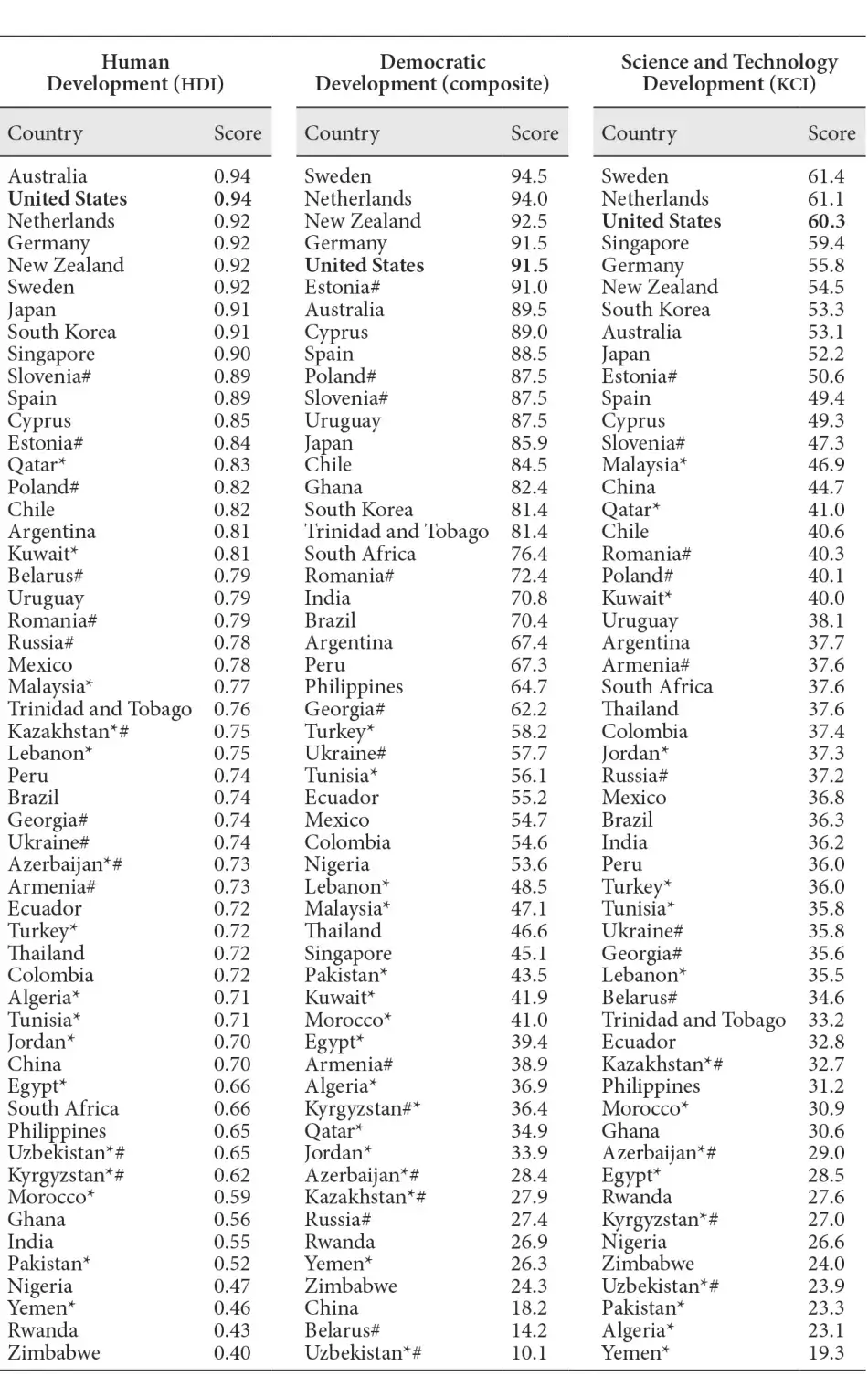
4. Post-Soviet/Eastern Bloc Country: We included a binary variable (0 versus 1) that indicates whether a country was previously a Soviet or Eastern Bloc country. Of the fifty-four countries, thirteen were coded as post-Soviet/Eastern Bloc (see Table 5).
5. Muslim-Majority Country: We included a binary variable (0 versus 1) that indicates whether a country was Muslim-majority. Of the fiftyfour countries, sixteen were coded as Muslim-majority (see Table 5).
In our MLM regression model we also included individual-level factors related to sociodemographic background, religious affiliation, secular values, interest in politics and economic beliefs, forms of media use, forms of institutional confidence/trust, and democratic values.
- Sociodemographics (six variables): We used six variables related to sociodemographic background, including age, gender (with male coded high), and educational attainment measured on a nine-point scale ranging from “no formal education” to “university level education with degree.” We also included a measure asking respondents to self-report their socioeconomic class ranging on a five-point scale from “lower class” (1) to “upper class” (5) and a dichotomous indicator of whether an individual was employed or not. The sixth variable measured an individual’s sense of economic security, calculated by averaging three survey items asking how often they had gone without food, gone without needed medicine, and gone without cash income (α = 0.81).
- Religious Affiliation (three variables): For respondents to surveys conducted across the fifty-four countries, the most popular religious affiliations were Muslim (24.2 percent; Sunni and Shia),32 Roman Catholic (18.3 percent), Protestant Christian (11.9 percent), Orthodox Christian (10.1 percent), and Hindu (4.8 percent). In addition, 18.3 percent of respondents cited “none” for their religious affiliation. For our analysis, we created dichotomous dummy variables for Roman Catholic, Protestant, and Orthodox Christian affiliations, with all other religious denominations serving as the reference category.
- Secular Values (four variables): From the WVS survey, we included four measures of secular values originally developed by the political scientist Christian Welzel.33 These four variables include defiance of traditional authority, moral relativism, skepticism of state authority, and degree of religiosity. As conceptualized by Welzel, each variable measures a unique dimension of individual detachment “from external sources of quasi-sacred authority, like religion, the nation, the state, and group norms.”34
- Defiance of traditional authority was measured by three questions that asked whether respondents’ main goal in life was to make their parents proud; whether greater respect for authority was good or bad; and how proud respondents were to identify with the nation in which they lived (for example, to be an “American” or “Chinese”). Responses to each question were averaged and combined, resulting in a multipoint index from 0 to 1, with greater defiance scored high.
- Moral relativism was measured by three questions asking respondents if they thought it could always be justified, never be justified, or something in between to avoid a fare on public transport, cheat on taxes if provided the chance, and accept a bribe in the course of professional duties. Responses were recoded into a dummy variable for each item, with 0 as “never justifiable” and all other responses as 1. The scores were then averaged over the three dummies, yielding a four-point index from 0 to 1.
- Degree of religiosity was measured using three questions asking respondents how important religion was in their life, how often they attended religious services, and whether or not they considered themselves to be a religious person, not a religious person, or an atheist. Responses to these questions were averaged and recoded into an multipoint index from 0 to 1, with higher scores reflecting greater religious devotion.
- Skepticism of state authority was measured by three questions asking respondents how much confidence they had in the armed forces, the police, and the courts. Responses were recoded as 0 for a “great deal” of confidence, 0.33 for “quite a lot” of confidence, 0.66 for “not very much” confidence, and 1 for “none at all.” The three items were then averaged and combined into a multipoint index from 0 to 1.
- Interest in Politics and Economic Beliefs (four variables):
- Political interest was assessed by averaging two variables tapping the importance respondents placed on politics and their expressed interest in politics (items correlated at r = 0.54).
- Belief in economic competition was assessed by averaging two survey items asking respondents how much they value economic competition and hard work (r = 0.38).
- Belief in government ownership asked about respondents’ support for increased government ownership of business and industry.
- Economic satisfaction was measured using a single item asking respondents on a ten-point scale how satisfied they were with their own financial situation.
- Institutional Confidence (five variables): We included five single-item measures assessing an individual’s confidence on a four-point scale (from none at all to a great deal) in institutions that commonly intersect with beliefs about science, technology, and society. These included universities, business, government, churches, and environmental organizations.
- Media Use (two variables): We measured media use by way of multi-item indexes that assessed frequency of traditional news media use and frequency of digital media use. The measure of traditional news media averaged three single survey items asking respondents about the frequency of their consumption of print news, TV news, and radio news on a five-point scale. The measure of digital media use averaged three survey items asking about the frequency of use of mobile phones, email, and the Internet.
- Democratic Values (two variables): We included measures of the perceived importance of democracy and support for authoritarian governance.
- Perceived importance of democracy was measured with a single item asking how important democracy was on a ten-point scale, with higher scores reflecting greater perceived importance.
- Support for authoritarian governance included three averaged questions asking respondents about their support level for governance by way of a strong leader, experts, or the army instead of by way of a democratic system.
Predicting Optimism about Science, Technology, and Society
As Model 4 in Table 6 details, after entering all individual- and country-level covariates into the model, we found that populations of Muslim-majority and post-Soviet/Eastern Bloc countries were more likely to express optimism about the impacts of science and technology on society, believing that advances and innovations make their lives healthier, easier, and more comfortable, create more opportunities for the next generation, and make the world a lot better off.
In contrast, people in more-developed countries who enjoy a higher standard of living as measured by the Human Development Index and greater political freedoms via democratic development tended to be less optimistic about the benefits that science and technology may offer. Our finding is consistent with previous theorizing on the postindustrial paradox, in which publics in more-advanced economies become more ambivalent about the costs and trade-offs of scientific research and technological advances.
Yet even controlling for human, economic, and democratic development, people living in countries with greater scientific and technological development as measured by per capita scientific publications, patents, and citations tended to be more optimistic about science and technology. Whether such optimism creates a culture that drives scientific ambition and productivity or whether such outputs boost optimism is not a question we can answer with our data. The most likely explanation, however, is a reinforcing, virtuous circle of optimism driving output and output reinvigorating optimism, irrespective of the stage of economic and democratic development a country may be in. In all, controlling for individual-level factors within countries, our model predicts 53 percent of the between-country differences in terms of scientific optimism.
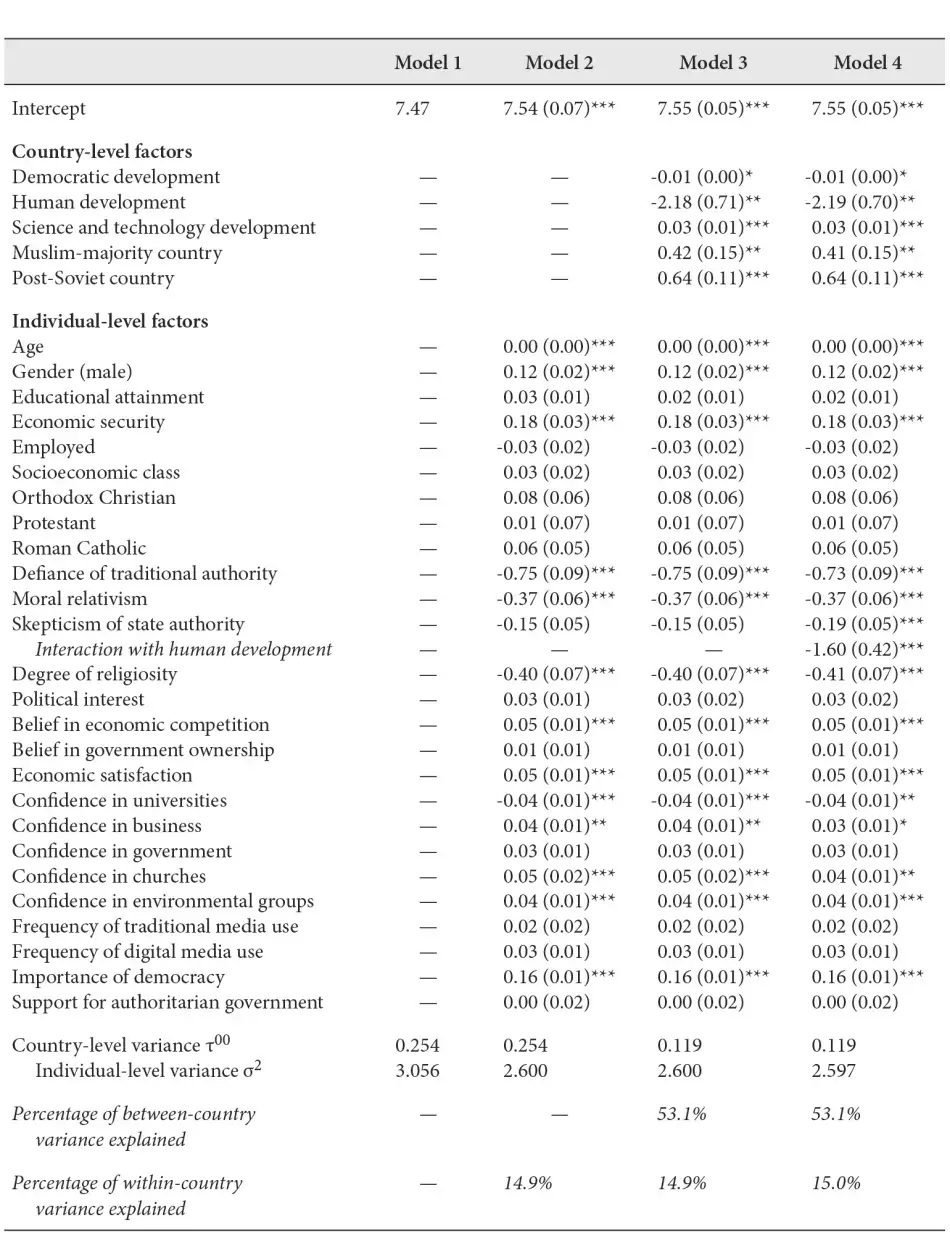
Finally, to compare the relative magnitude of each of the statistically significant country-level predictors of optimism about science and technology, we manually standardized each coefficient by taking the estimated unstandardized coefficient obtained from the HLM output, multiplying it by the standard deviation of the predictor variable, and dividing it by the standard deviation of the scientific optimism measure. In this case, the strongest country-level predictors of an individual’s scientific optimism were science and technology development (β = 0.17), human development (β = -0.16), and residence (or not) in a post-Soviet/Eastern Bloc country (β = 0.15).
Shifting our focus to individual-level factors, as Table 6 details, we found that among those surveyed across the fifty-four countries, after all controls, men and those enjoying greater economic security were more likely to express optimism about science and technology. Somewhat surprisingly, neither socioeconomic class nor Christian denominational identity were significantly related to scientific optimism. Notably, expressions of scientific optimism were also associated with classical liberal values oriented toward the market, openness, free enterprise, free inquiry, and the pursuit of new knowledge, networks, and information. More specific, across countries, scientific optimists tended to believe in economic competition and the importance of democracy, they were more likely to use and seek out information and connections via digital media, and they were more likely to express economic satisfaction, along with confidence in universities, business, and civil society groups like environmental nonprofits.
In contrast, respondents with greater confidence in religious institutions and who are more religiously devout scored lower on scientific optimism. As did respondents who are more distrustful of various forms of societal authority and conventional norms. Specifically, those who are defiant of traditional authority in the form of the family or national identity, who are more skeptical of state authority in the form of the police, military, and the courts, and who are morally relativistic are less likely to express optimism about science and technology.
There is, however, one important caveat to these relationships. When we examined the relationship between individual-level beliefs about state authority and country-level context, we observed that the influence of state authority skepticism on scientific optimism is significantly more pronounced among those living in highly developed countries (see Figure 1). In wealthy countries, for individuals who distrust the police, military, or courts, they may be more prone to view the close association between scientific research, technological innovation, militarization, and surveillance as operating in the service of social control, rather than economic growth, as their counterparts in developing countries might primarily view science. Overall, our final model including country-level and individual-level factors accounted for 15 percent of within-country, individual variation in scientific optimism.
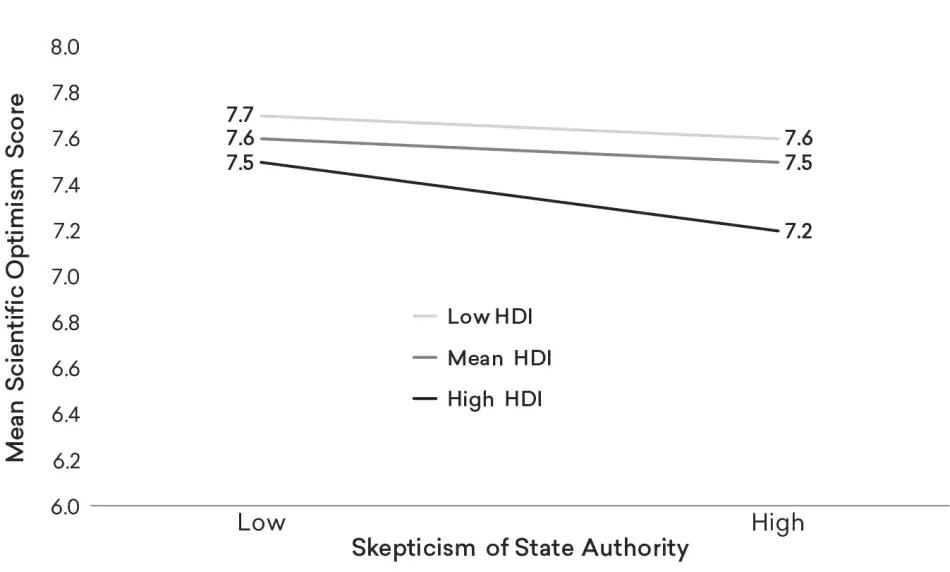
Last, to compare the relative magnitude of each of the statistically significant individual predictors of optimism about science and technology, we manually standardized each coefficient (see earlier discussion). In this case, the strongest individual-level predictors of scientific optimism were the perceived importance of democracy (β = 0.19), followed by economic security (β = 0.09) and moral relativism (β = -0.08).
Predicting Reservations about Science, Technology, and Society
Turning to reservations about science and technology, as Model 4 in Table 7 details, after all controls, in parallel to the findings on scientific optimism, the populations of Muslim-majority and post-Soviet/Eastern Bloc countries were less likely to express concerns about the impact of science and technology on faith and morality, and less likely to question whether science was important to their lives. Similarly, after controlling for every other variable in the model, those individuals living in nations with greater levels of scientific activity and innovation were less likely to express reservations about their impact than their counterparts living in other countries. When we compared the relative magnitude of these statistically significant predictors of reservations (see earlier discussion), we found that a country’s level of scientific and technological development was by far the most influential variable (β = 0.32), followed by whether or not an individual lived in a Muslim-majority country (β = -0.12). Interestingly, in contrast to scientific optimism, a nation’s human development and democratic development were not predictive of individual reservations about science and society.
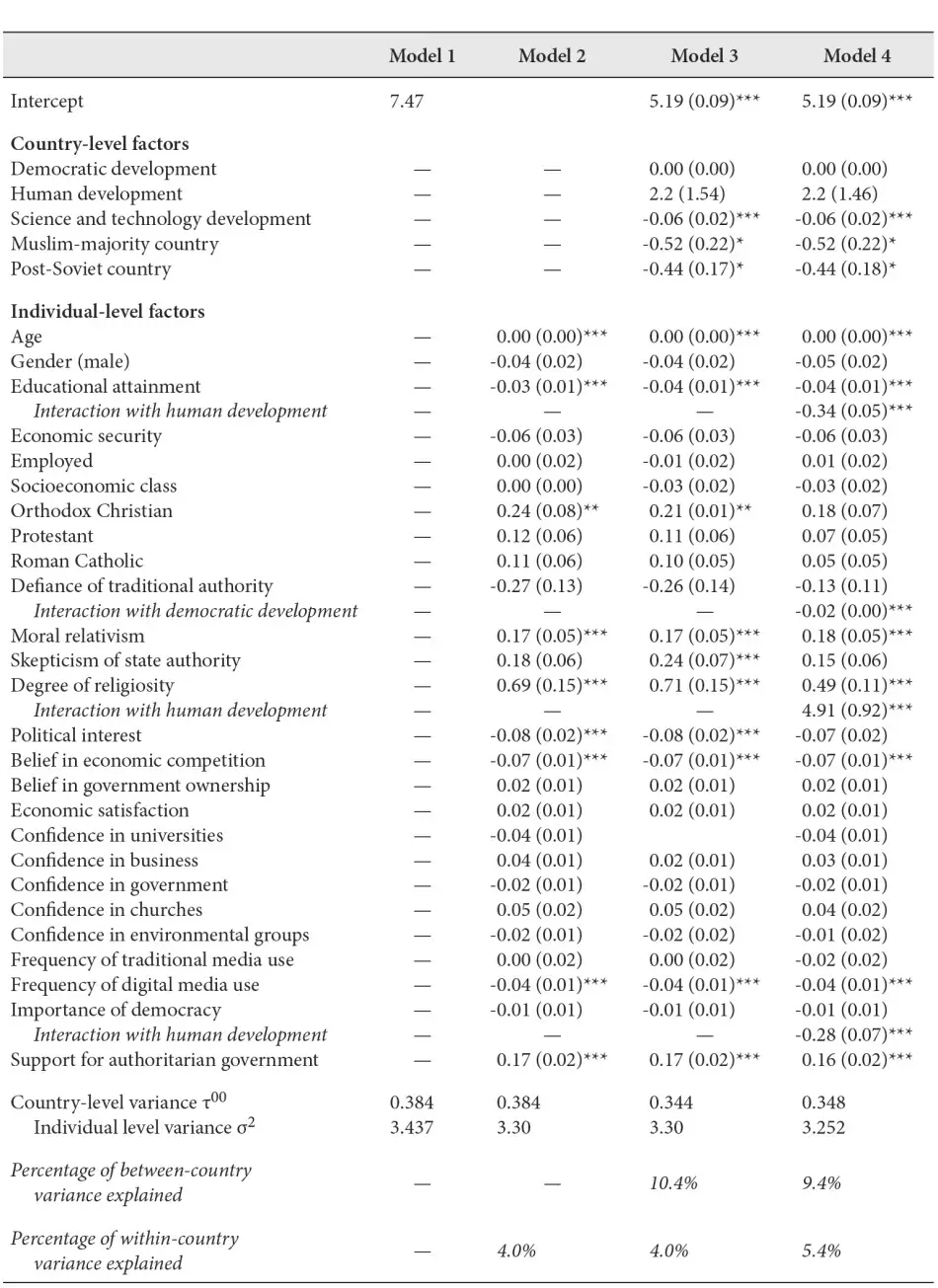
Among individual-level socioeconomic factors, only education was significantly related to scientific reservations, with the better educated expressing fewer reservations. The influence of education, however, varied across countries by level of human development. The least educated living in the richest countries tended to express much higher levels of scientific reservations than the least educated living in poorer countries. These individuals may justifiably believe that they cannot afford or do not have access to medical advances or technological innovations; or they may fear that such innovations in areas like robotics or automation will disrupt their jobs and communities. In contrast, the well-educated across societies are likely to view science and technology in terms of bettering their lives and professions. Lower levels of reservations among highly educated individuals, regardless of the country in which they live, is consistent with formal education having a socializing influence that shapes individuals’ views about science in terms of progress and optimism, rather than in terms of the moral and religious implications (see Figure 2).35
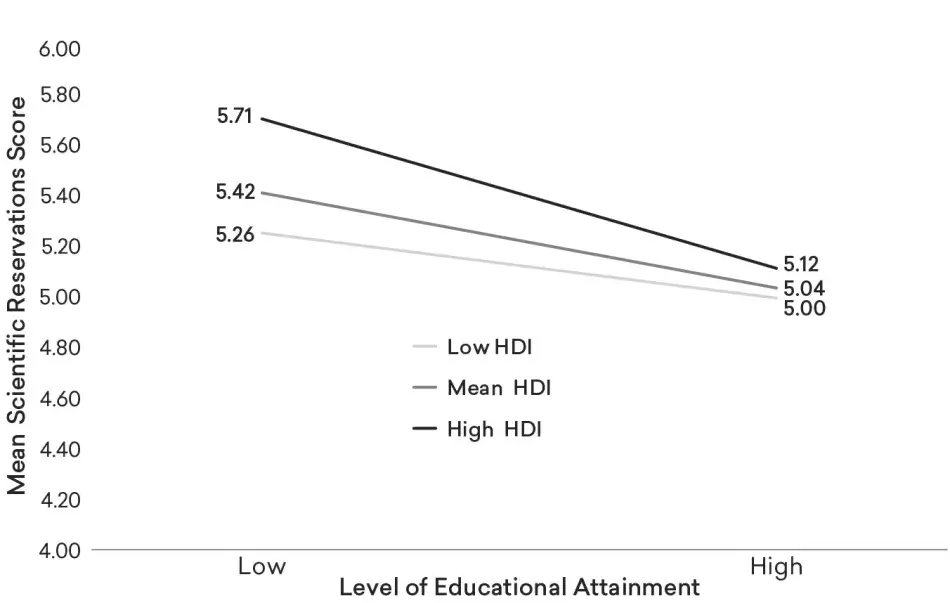
Similar to scientific optimism, after all controls, those individuals across countries who hold classical liberal values, specifically those who believe in economic competition and value the openness and connections made possible by digital media use, tend to hold fewer reservations about science and technology. In contrast, those who discount the importance of democracy in favor of authoritarianism express greater levels of scientific reservations. This relationship is the most pronounced in highly developed countries (see Figure 3). The reason for this relationship is unclear, but it may relate to the rise of authoritarianism, anti-elitism, and populist distrust of technocrats in Europe and the United States over the past decade.36

Given that the reservations-related questions asked directly about the impact of science on faith and morality, it is not surprising that people across countries who are more religiously devout scored higher on the measure. But in this case, there is a contingency to note. Expressions of anxiety among the most religious tend to be greatest for those living in highly developed countries. For religious individuals lucky enough to live in a country that has achieved a high material standard of living, the normative trade-offs relative to new scientific advances appear to become more personally relevant than for their religious counterparts living in countries where science may still be seen as an essential vehicle for escaping material deprivation (see Figure 4).
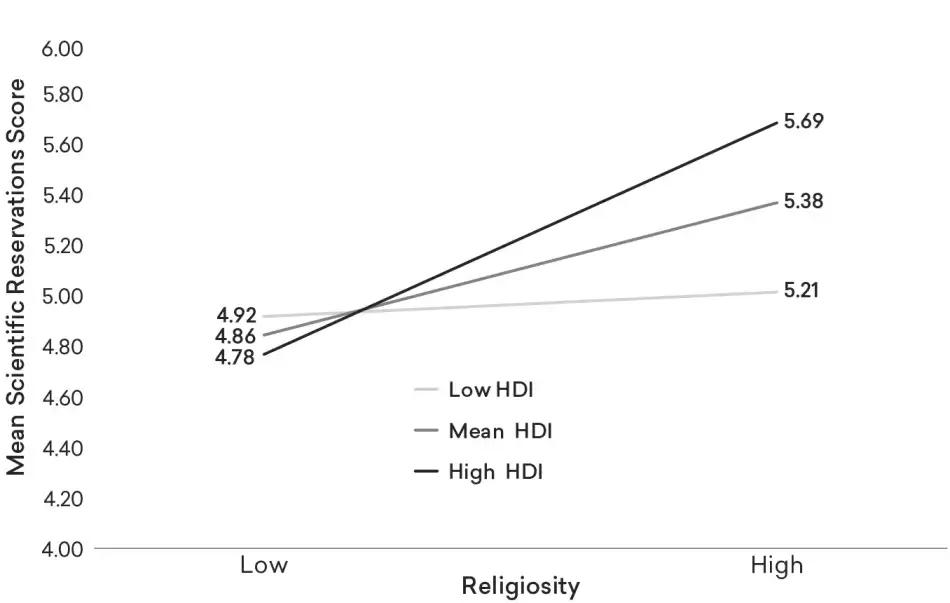
Apart from the religious, those who are more distrustful of various forms of societal authority and conventional norms also expressed greater reservations about science. Somewhat paradoxically, moral relativism across countries is significantly related to reservations about the impact of science and technology on faith, morality, and the perceived importance to life. Notably, the relationship between defiance of traditional authority and scientific reservations varies strongly by the level of democratic development in a country. In countries with fewer civil liberties and press freedoms, science may still be closely associated with forms of government and societal control; thus, those who are distrusting of traditional authority expressed higher levels of scientific reservations. In contrast, their counterparts living in strongly democratic countries expressed far fewer reservations about science and technology (see Figure 5).
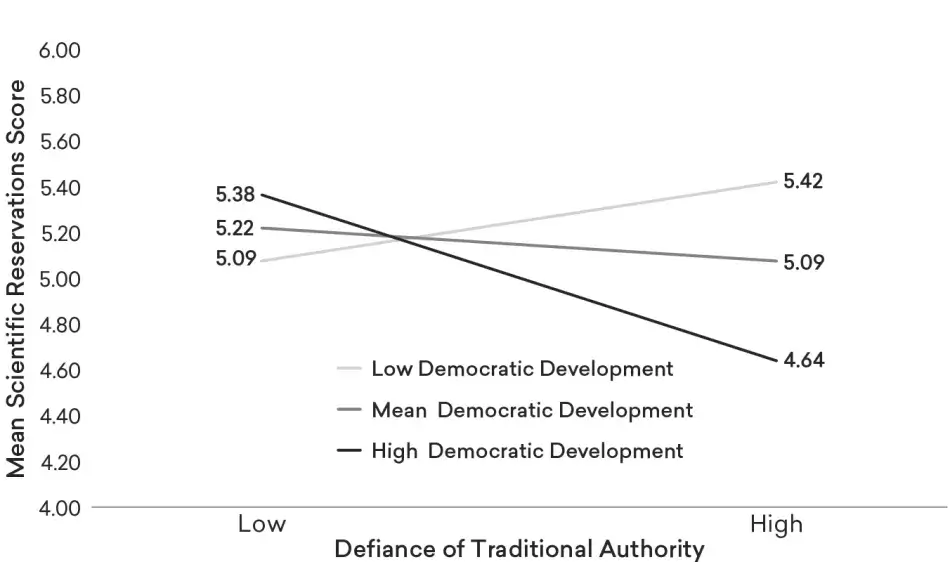
Finally, to assess which of the statistically significant individual-level predictors in the model had the greatest influence on reservations about science and technology, we standardized each of the respective variable’s coefficients (see earlier discussion). In this case, after all controls, an individual’s degree of religiosity had the strongest relationship with reservations (β = 0.11), followed by support for authoritarian governance (β = 0.08) and belief in economic competition (β = -0.08).